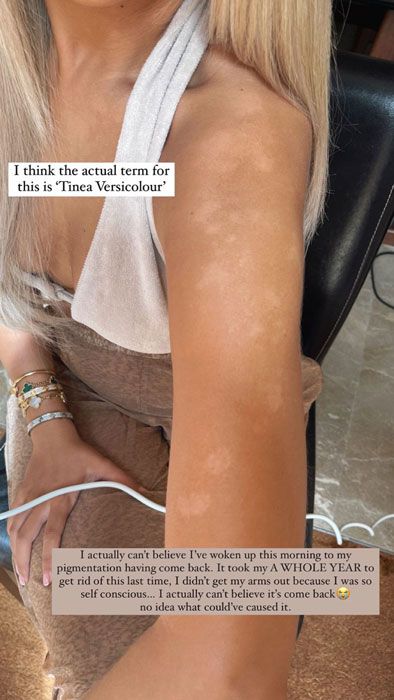Molly-Mae Hague took to Instagram today to share that she'd had a flare-up of tinea versicolor, an incurable pigmentation skin condition that leaves the skin looking patchy.
MORE: Molly-Mae back in hospital after delaying appointment four times
The Love Island star, 22, shared a photo of her arm with the condition on show, captioned: "I actually can't believe I've woken up this morning to my pigmentation having come back. It took me a whole year to get rid of this last time. I didn't get my arms out because I was so self-conscious. I actually can't believe it's come back [crying emoji]. No idea what could have caused it."
WATCH: Molly-Mae Hague worried for her life amid severe period pain
She also wrote: "I think the actual term for this is tinea versicolor."
MORE: Molly-Mae opens up about 'excruciating' health issue she's had since she was 15
SEE: Molly-Mae reveals overhaul plans at £4million mansion - fans react
What is tinea versicolor pigmentation?
Tinea versicolor, also known as pityriasis versicolor, is a common fungal skin infection that can cause patches of skin to change colour. According to the NHS website, a GP can prescribe treatment for the condition, but it can keep coming back. According to dermatologist Dr. Hasan Benar, who works at Dr Elif Clinic, it is caused by an overgrowth of a yeast fungus that is naturally present on the skin. "The overproduction of this yeast causes pigment-producing cells to react, which causes the infection."
Molly-Mae shared this photo of her skin condition on Instagram
While Molly-Mae said she had no idea what caused her flare-up, Dr. Hasan Benar told us that warm or humid conditions can cause a reoccurrence of tinea versicolor.
As with Molly-Mae's pigmentation, the patches usually appear on the chest, upper back, upper arms, neck or stomach and present themselves as pink, red or pale brown patches that do not tan in the sun.
RELATED: Louise Redknapp reveals her battle with pigmentation in holiday selfie
Tinea versicolor only tends to go away when treated, but as Molly Mae said, it can take a long time to fade, plus it is likely to return.
Molly-Mae said she wears long sleeves to cover her pigmentation
Treatments for tinea versicolor
A doctor normally prescribes antifungal cream or shampoo to treat affected areas, or tablets if the pigmentation is across a large area. The NHS website notes it can take months to fade.
MORE: How to tackle pigmentation - from one of Hollywood's top dermatologists
What causes tinea versicolor?
The NHS says tinea versicolor is caused by a type of fungus that lives on the skin.
"Most people have this fungus on their skin without it causing any problems. But sometimes it can grow and spread more than usual, causing the condition," the NHS website says. It continues that it’s not clear why it happens to some people, but the condition is not contagious.
Like this story? Sign up to our HELLO! Mail newsletter to get other stories like this delivered straight to your inbox.











